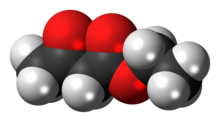Ethyl acetoacetate

| |

| |
| Names | |
|---|---|
| Preferred IUPAC name
Ethyl 3-oxobutanoate | |
Other names
| |
| Identifiers | |
3D model (JSmol)
|
|
| ChEBI | |
| ChEMBL | |
| ChemSpider | |
| ECHA InfoCard | 100.005.015 |
| EC Number |
|
| KEGG | |
PubChem CID
|
|
| RTECS number |
|
| UNII | |
| UN number | 1993 |
CompTox Dashboard (EPA)
|
|
| |
| |
| Properties | |
| C6H10O3 | |
| Molar mass | 130.14 g/mol |
| Appearance | Colourless liquid |
| Odor | Fruit or rum |
| Density | 1.030 g/cm3, liquid |
| Melting point | −45 °C (−49 °F; 228 K) |
| Boiling point | 180.8 °C (357.4 °F; 453.9 K) |
| 2.86 g/100 ml (20 °C) | |
| Acidity (pKa) |
|
| −71.67×10−6cm3/mol | |
Refractive index (nD)
|
1.420 |
| Hazards | |
| GHS labelling:[1] | |

| |
| Warning | |
| H319 | |
| P305+P351+P338 | |
| NFPA 704 (fire diamond) | |
| Flash point | 70 °C (158 °F; 343 K) |
| Related compounds | |
Related esters
|
|
Related compounds
|
|
Except where otherwise noted, data are given for materials in their standard state (at 25 °C [77 °F], 100 kPa).
| |
The organic compound ethyl acetoacetate (EAA) is the ethyl ester of acetoacetic acid. It is a colorless liquid. It is widely used as a chemical intermediate in the production of a wide variety of compounds.
Preparation
[edit]At large scale, ethyl acetoacetate is industrially produced by treatment of diketene with ethanol.[2]
The small scale preparation of ethyl acetoacetate is a classic laboratory procedure.[3] It involves Claisen condensation of ethyl acetate. Two moles of ethyl acetate condense to form one mole each of ethyl acetoacetate and ethanol.[4]
Reactions
[edit]Ethyl acetoacetate is subject to keto-enol tautomerism. In the neat liquid at 33 °C, the enol consists of 15% of the total.[5]
The enol is moderately acidic. Thus ethyl acetoacetate behaves similarly to acetylacetone:[6]
- CH3C(O)CH2CO2C2H5 + NaH → CH3C(O)CHNaCO2C2H5 + H2
The resulting carbanion undergoes nucleophilic substitution. Ethyl acetoacetate is often used in the acetoacetic ester synthesis, comparable to diethyl malonate in the malonic ester synthesis or the Knoevenagel condensation. After its alkylation and saponification, thermal decarboxylation is also possible.[7]
The dianion of ethyl acetoacetate is also a useful building block, except that the electrophile adds to the terminal carbon. The strategy can be depicted in the following simplified form:[6]
- CH3C(O)CHNaCO2C2H5 + BuLi → LiCH2C(O)CHNaCO2C2H5 + BuH (Bu = butyl)
Reduction of ethyl acetoacetate gives ethyl 3-hydroxybutyrate.[8]
Ethyl acetoacetate transesterifies to give benzyl acetoacetate via a mechanism involving acetylketene. Ethyl (and other) acetoacetates nitrosate readily with equimolar sodium nitrite in acetic acid, to afford the corresponding oximinoacetoacetate esters. A dissolving-zinc reduction of these in acetic acid in the presence of ketoesters or beta-diketones constitute the Knorr pyrrole synthesis, useful for the preparation of porphyrins.
Another similarity to acetylacetone, ethyl acetoacetate forms chelate complexes, such as Al(CH3C(O)CHCO2C2H5)3[9] and the Fe(III) derivative.[10]
See also
[edit]Two ketals of ethyl acetoacetate are used in commercial fragrances.[11]
- Fructone (CH3C(O2C2H4)CH2CO2C2H5), the ethylene glycol ketal
- Fraistone (CH3C(O2C2H3CH3)CH2CO2C2H5), the propylene glycol ketal
Safety and environmental considerations
[edit]Ethyl acetoacetate has low toxicity to animals. It is highly biodegradable.[2]
References
[edit]- ^ Record in the GESTIS Substance Database of the Institute for Occupational Safety and Health, accessed on 2021-12-19.
- ^ a b Riemenschneider, Wilhelm; Bolt, Hermann M. (2005). "Esters, Organic". Ullmann's Encyclopedia of Industrial Chemistry. Weinheim: Wiley-VCH. doi:10.1002/14356007.a09_565.pub2. ISBN 3527306730.
- ^ J. K. H. Inglis and K. C. Roberts (1926). "Ethyl Acetoacetate". Organic Syntheses. 6: 36. doi:10.15227/orgsyn.006.0036.
- ^ Tan, Da-Zhi; Li, Ming-Ze; Xiong, Wan-nan; Xu, Yi-Xuan; Pan, Yang; Fan, Wen-Jie; Jiang, Wen-Feng (2023). "Improvement of the Ethyl Acetoacetate Preparation Experiment: A Green Chemistry Experiment". Journal of Chemical Education. 100 (2): 811–814. Bibcode:2023JChEd.100..811T. doi:10.1021/acs.jchemed.2c00718.
- ^ Jane L. Burdett; Max T. Rogers (1964). "Keto-Enol Tautomerism in β-Dicarbonyls Studied by Nuclear Magnetic Resonance Spectroscopy. I. Proton Chemical Shifts and Equilibrium Constants of Pure Compounds". J. Am. Chem. Soc. 86: 2105–2109. doi:10.1021/ja01065a003.
- ^ a b Jin, Yinghua; Roberts, Frank G.; Coates, Robert M. (2007). "Stereoselective Isoprenoid Chain Extension with Acetoacetate Dianion: [(E, E, E)-Geranylgeraniol from (E, E)-Farnesol". Organic Syntheses. 84: 43. doi:10.15227/orgsyn.084.0043.
- ^ Carey, Francis A. (2006). Organic Chemistry (Sixth ed.). New York, NY: McGraw-Hill. ISBN 0-07-111562-5.
- ^ Adkins, Homer; Connor, Ralph; Cramer, Howard (1930). "The Hydrogenation of Acetoacetic Ester and Certain of Its Derivatives over Nickel". Journal of the American Chemical Society. 52 (12): 5192–5198. doi:10.1021/ja01375a082.
- ^ Charles, R. G.; Peterson, N. C.; Franke, G. H. (1967). Aluminum Derivative of Ethyl Acetoacetate. Inorganic Syntheses. Vol. 9. pp. 25–27. doi:10.1002/9780470132401.ch8. ISBN 978-0-470-13168-8.
- ^ Urs, Usha K.; Shalini, K.; Shivashankar, S. A.; Guru Row, T. N. (2000). "Low-Temperature Tris(tert-butyl 3-oxobutanoato)iron(III)". Acta Crystallographica Section C Crystal Structure Communications. 56 (10): e448 – e449. Bibcode:2000AcCrC..56E.448U. doi:10.1107/S010827010001249X.
- ^ Panten, Johannes; Surburg, Horst (2016). "Flavors and Fragrances, 3. Aromatic and Heterocyclic Compounds". Ullmann's Encyclopedia of Industrial Chemistry. pp. 1–45. doi:10.1002/14356007.t11_t02. ISBN 978-3-527-30673-2.


